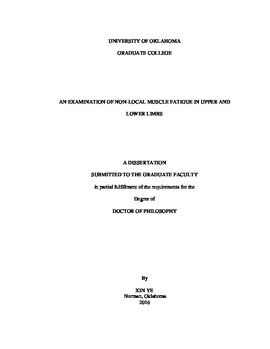| dc.description.abstract | Non-local muscle fatigue (NLMF) is a phenomenon that has been described and examined extensively in literature. Traditionally, interventions have been applied in the unilateral limb to examine the potential short-term “cross-over” fatigue and long-term “cross education” effects in the contralateral limb. More recently, an emphasis is placed on the examination of unrelated heterogonous muscle groups after fatiguing the unilateral muscle groups (e.g. fatiguing upper limb and examining the motor performance of distal and unrelated lower limb muscles, or vice versa), as evidence was shown that the motor performance could be impaired in the non-exercised muscles. PURPOSE: To examine the possible changes in the neuromuscular properties and motor control strategies of both the contralateral homogenous and non-related heterogonous muscles following fatiguing exercise interventions on the unilateral muscle groups. METHODS: Eighteen subjects voluntarily participated in this 5-visit investigation. After the first visit as familiarization, subjects went through 4 separate randomly sequenced experimental visits, during which fatiguing interventions and testing were applied on different limbs (fatigue the right forearm flexors and test the left forearm flexors; fatigue the right forearm flexors and test the left leg extensors; fatigue the right leg extensors and test the left forearm flexors; fatigue the right leg extensors and test the left forearm flexors). Maximal isometric strength, force fluctuations during submaximal contraction, as well as surface electromyographic (EMG) signals were collected before and after the fatiguing interventions. In addition, surface EMG signals from the submaximal contractions were decomposed into individual motor unit action potential trains, and linear regression analysis was used to examine the relationship between motor unit mean firing rate and recruitment threshold. RESULTS: There was a significant decrease in maximal isometric strength in the non-exercised forearm flexors, but not in the non-exercised leg extensors. Consistent with this finding, the force became less steady during submaximal contractions in the non-exercised forearm flexors. However, the decreased motor performance was not accompanied with a decline in the EMG amplitude or altered motor control strategies. CONCLUSIONS: Six sets of 30-s maximal isometric contractions performed in the right forearm flexors and right leg extensors induced non-local muscle fatigue in the non-exercised left forearm flexors, but not in the leg extensors. Due to non-local muscle fatigue, the subjects’ ability to maintain a steady constant force was impaired. Contradicting to the prevailing explanations of the NLMF, the EMG data from our study does not necessarily support the “central fatigue” mechanism, due to the lack of evidence of changes in EMG parameters and motor unit activity from the non-exercised biceps brachii. On the other hand, although the motor performance of the non-exercised left extensors was not affected by the fatiguing interventions, fatiguing upper body muscle vs. lower body muscle seemed to have differential effects on the motor unit firing behaviors from the non-exercised vastus lateralis. However, this difference was probably too small to induce significant changes in motor performance. | en_US |
